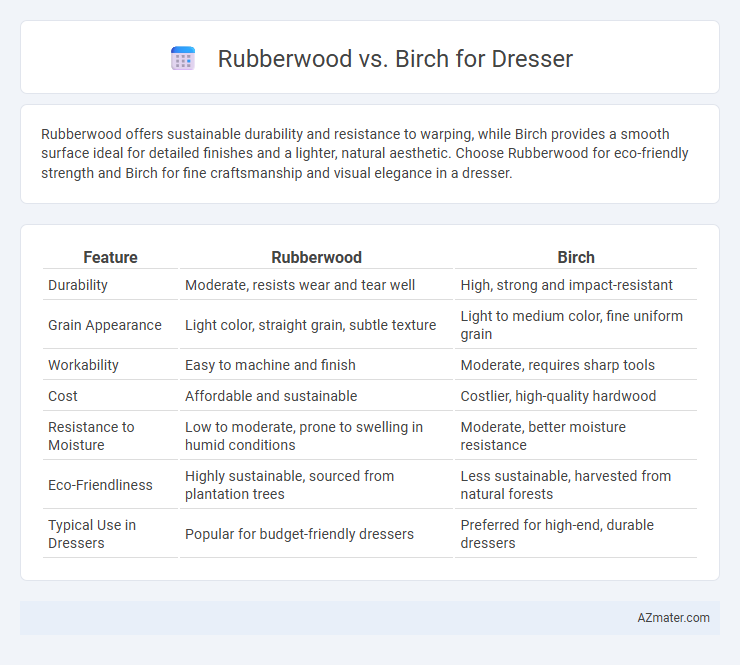Rubberwood offers sustainable durability and resistance to warping, while Birch provides a smooth surface ideal for detailed finishes and a lighter, natural aesthetic. Choose Rubberwood for eco-friendly strength and Birch for fine craftsmanship and visual elegance in a dresser.
Table of Comparison
| Feature | Rubberwood | Birch |
|---|---|---|
| Durability | Moderate, resists wear and tear well | High, strong and impact-resistant |
| Grain Appearance | Light color, straight grain, subtle texture | Light to medium color, fine uniform grain |
| Workability | Easy to machine and finish | Moderate, requires sharp tools |
| Cost | Affordable and sustainable | Costlier, high-quality hardwood |
| Resistance to Moisture | Low to moderate, prone to swelling in humid conditions | Moderate, better moisture resistance |
| Eco-Friendliness | Highly sustainable, sourced from plantation trees | Less sustainable, harvested from natural forests |
| Typical Use in Dressers | Popular for budget-friendly dressers | Preferred for high-end, durable dressers |
Introduction: Why Compare Rubberwood and Birch for Dressers?
Rubberwood and birch are popular hardwood choices for dresser construction due to their durability and aesthetic appeal. Rubberwood offers a sustainable, eco-friendly option sourced from plantation trees, while birch provides a tight grain and uniform texture ideal for smooth finishes. Comparing these woods helps determine the best balance of cost, strength, and visual quality for long-lasting, attractive dressers.
Overview of Rubberwood and Birch
Rubberwood is a sustainable hardwood commonly used in furniture making, known for its light color, fine grain, and resistance to warping, making it ideal for dressers. Birch, a dense hardwood with a smooth texture and pale color, offers excellent durability and a clean, modern appearance for bedroom furniture. Both woods are favored for their strength and versatility, but Rubberwood's eco-friendly sourcing contrasts with Birch's traditional hardwood status.
Appearance and Grain Patterns
Rubberwood offers a pale, creamy color with subtle, straight grain patterns that provide a clean and uniform look for dressers. Birch features a light, warm tone complemented by fine, tight grain patterns that often display a smooth, slightly wavy texture, adding natural elegance. The choice between Rubberwood and Birch depends on desired visual warmth and grain intricacy, with Birch typically presenting more character and Rubberwood delivering a consistent, minimalist aesthetic.
Durability and Strength Comparison
Rubberwood offers moderate durability and is resistant to warping, making it suitable for lightweight furniture like dressers. Birch exhibits superior strength and hardness, providing excellent resistance to dents and scratches, which ensures long-lasting durability in high-use dressers. The dense grain structure of birch enhances overall structural integrity compared to the more porous rubberwood.
Sustainability and Environmental Impact
Rubberwood, sourced from aged rubber trees after latex extraction, is highly sustainable due to its renewable lifecycle and efficient reuse of plantation resources, minimizing deforestation. Birch, while durable and strong, is typically harvested from slower-growing forests, potentially contributing to less sustainable forestry practices if not sourced responsibly. Choosing rubberwood dressers supports environmentally conscious purchasing by reducing waste and promoting plantation forestry management.
Workability and Ease of Crafting
Rubberwood offers excellent workability due to its uniform grain and moderate hardness, making it easy to cut, shape, and sand for dresser construction. Birch, known for its fine, tight grain and hardness, provides superior durability but requires sharper tools and more effort to craft intricate details. Both woods finish well, but rubberwood's ease of machining often speeds up production without sacrificing quality.
Cost Differences
Rubberwood offers a cost-effective option for dressers due to its abundance and rapid growth cycle, making it significantly cheaper than birch. Birch, known for its durability and fine grain, commands a higher price because of its slower growth and greater processing requirements. Choosing rubberwood can reduce overall dresser expenses by 20-40% compared to birch, balancing affordability with decent quality.
Maintenance and Care Requirements
Rubberwood dressers require moderate maintenance, needing occasional polishing and protection from excessive moisture to prevent warping, while Birch dressers demand more frequent sealing or varnishing to maintain their natural light finish and protect against scratches. Both woods benefit from regular dusting with a soft cloth, but Birch's tighter grain can better resist dirt accumulation compared to Rubberwood's porous structure. Choosing Rubberwood may imply more vigilance in avoiding water damage, whereas Birch requires more upkeep to preserve its aesthetic appeal over time.
Popular Uses in Dresser Manufacturing
Rubberwood is favored in dresser manufacturing for its affordability, sustainability, and light color, making it ideal for budget-friendly, eco-conscious furniture with a smooth finish. Birch is prized for its strength, fine grain, and durability, commonly used in higher-end dressers that require a robust structure and elegant appearance. Both woods offer versatility, but rubberwood suits mass-produced, casual styles, while birch supports premium, lasting dresser designs.
Final Verdict: Which Wood is Best for Dressers?
Rubberwood offers affordability, durability, and eco-friendly benefits, making it a practical choice for budget-conscious buyers seeking sustainable furniture. Birch provides a smooth grain, superior strength, and a lighter, more refined finish, ideal for high-end dressers requiring a polished aesthetic. For long-lasting, visually appealing dressers, birch is the best wood, while rubberwood suits those prioritizing cost-effectiveness and environmental sustainability.

Infographic: Rubberwood vs Birch for Dresser
 azmater.com
azmater.com